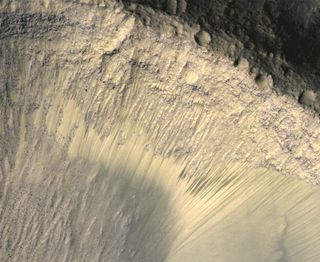Iron-Loving Bacteria a Model For Mars Life

Single-celled microbes are considered a living example of the kind of life that might exist elsewhere in the universe, as they are able to survive some of the extreme conditions that exist on other worlds.
New research on the bacterium Tepidibacillus decaturensis shows that it could be a model organism for what might live on Mars, should any creature inhabit the Red Planet. This microorganism, found in water more than a mile underground in the Illinois Basin in a formation known as Mount Simon Sandstone, has been shown to be moderately tolerant of heat and salt and able to persist in an anoxic environment. Mars itself is believed to harbor similarly briny surface water without the presence of oxygen.
A paper based on this research, entitled "Tepidibacillus decaturensissp. nov.: a microaerophilic, moderately thermophilic iron-reducing bacterium isolated from a depth of 1.7 km in the Illinois Basin, USA," was published in the International Journal of Systematic and Evolutionary Microbiology. [The Life on Mars Search: Photo Timeline]
The research was led by Yiran Dong, a research scientist at the Carl R. Woese Institute of Genomic Biology, Robert Sanford, a geomicrobiologist and research associate professor at the University of Illinois, Urbana-Champaign, and Bruce W. Fouke, a professor at the University of Illinois, Urbana-Champaign and was co-funded by the NASA Astrobiology Institute and the National Energy Technology Laboratory.
Drilling for CO2 sequestration
The research team piggybacked on drilling activity completed by the Midwest Geological Sequestration Consortium (MGSC), which includes the Illinois State Geological Survey (ISGS) and Archer Daniels Midland (ADM). Supported by the Department of Energy, this project is evaluating locations for storing carbon underground to sequester the enormous volume of CO2 emissions being produced by ADM industrial food production, Sanford explained.

The research team participated in two drill sessions that were completed on the grounds of the ADM facility in Decatur, Illinois. Both wells are within 1,000 feet of one another and clean deep, subsurface groundwater was collected at a variety of depths. The target lithology of the Mount Simon sandstone in this central portion of the Illinois Basin ranges from 1.5 kilometers (0.93 miles) to 2.2 kilometers (1.4 miles) in burial depth. This habitat also happens to have iron oxide minerals coating the sandstone grains, which is also true of much of the surface of Mars.
Get the Space.com Newsletter
Breaking space news, the latest updates on rocket launches, skywatching events and more!
“There have been some iron-reducers [bacteria] found at deep subsurface environments,” Sanford said. “These organisms have respiratory functions for reducing iron; they are reducing iron like we use oxygen. They use ferric iron to breathe.”
The bacterium they were studying, however, is a fermentative organism. Another example of this kind of organism is yeast, a fungus that converts sugar to alcohol through enzymes. Tepidibacillus decaturensis does not use iron to breathe, but it uses iron to sustain its metabolism in a very similar fashion to how yeast produce ethanol to sustain theirs.
Further research
The team is analyzing the genomic composition of Tepidibacillus decaturensis. Luckily, they have found another, separate iron-reducing bacterium from the same geological formation called Orenia metallireducens, the first known bacterial species in genus Orenia that reduces ferric to ferrous iron. (A study based on this finding was recently accepted in the journal Applied and Environmental Microbiology.)
The combination of these two iron-reducing bacteria will allow the scientists to conduct comparative studies of their metabolisms and ecology, permitting them to further explore these novel metal-reducing mechanisms. Two iron-dependent organisms in a similar environment provide valuable comparisons to understand how life behaves in these deep, hostile environments.

In previous work published in the journal Genome Announcements earlier in 2016, the team presented the first sequenced genome of Tepidibacillus decaturensis. They found nearly 3,000 protein-coding genes and 52 transfer RNA (tRNA) genes; tRNA is used to decode messenger RNA sequences into proteins.
"We are trying to see whether there are some new [gene] features to set up experiments to test them, and thus explore for the first time the deep evolutionary history of these organisms on Earth and potentially Mars," Dong said of the ongoing work.
Join our Space Forums to keep talking space on the latest missions, night sky and more! And if you have a news tip, correction or comment, let us know at: community@space.com.

Elizabeth Howell (she/her), Ph.D., is a staff writer in the spaceflight channel since 2022 covering diversity, education and gaming as well. She was contributing writer for Space.com for 10 years before joining full-time. Elizabeth's reporting includes multiple exclusives with the White House and Office of the Vice-President of the United States, an exclusive conversation with aspiring space tourist (and NSYNC bassist) Lance Bass, speaking several times with the International Space Station, witnessing five human spaceflight launches on two continents, flying parabolic, working inside a spacesuit, and participating in a simulated Mars mission. Her latest book, "Why Am I Taller?", is co-written with astronaut Dave Williams. Elizabeth holds a Ph.D. and M.Sc. in Space Studies from the University of North Dakota, a Bachelor of Journalism from Canada's Carleton University and a Bachelor of History from Canada's Athabasca University. Elizabeth is also a post-secondary instructor in communications and science at several institutions since 2015; her experience includes developing and teaching an astronomy course at Canada's Algonquin College (with Indigenous content as well) to more than 1,000 students since 2020. Elizabeth first got interested in space after watching the movie Apollo 13 in 1996, and still wants to be an astronaut someday. Mastodon: https://qoto.org/@howellspace

